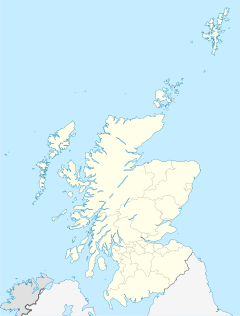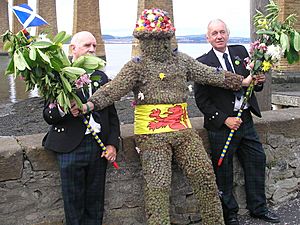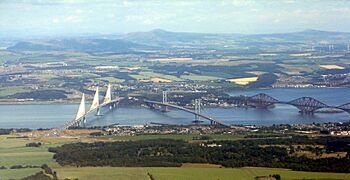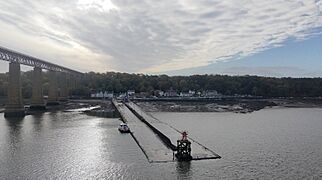South Queensferry facts for kids
Quick facts for kids Queensferry
|
|
|---|---|
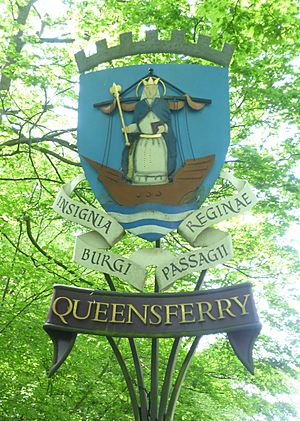 Sign on entering Queensferry, displaying the arms of the burgh |
|
| Population | 10,400 (2020) |
| OS grid reference | NT129783 |
| Council area |
|
| Lieutenancy area | |
| Country | Scotland |
| Sovereign state | United Kingdom |
| Post town | SOUTH QUEENSFERRY |
| Postcode district | EH30 |
| Dialling code | 0131 |
| Ambulance | Scottish |
| EU Parliament | Scotland |
| UK Parliament |
|
| Scottish Parliament |
|
Queensferry, also known as South Queensferry or "The Ferry", is a town in Scotland. It is located west of Edinburgh. This historic town used to be a royal burgh of West Lothian. Today, the City of Edinburgh Council manages it.
Queensferry sits about ten miles northwest of Edinburgh city centre. It is on the shore of the Firth of Forth. The town is famous for being near three large bridges: the Forth Bridge, the Forth Road Bridge, and the Queensferry Crossing.
The name South Queensferry helps tell it apart from North Queensferry. North Queensferry is on the opposite side of the Forth. Both towns got their names from a ferry service. Queen Margaret started this ferry in the 11th century. It ran until 1964, when the Forth Road Bridge opened.
In 2022, South Queensferry had 10,216 residents. In 2011, its population was 9,026. This number included the nearby area of Dalmeny.
Contents
What's in a Name?
The Gaelic name for South Queensferry is Taobh a Deas Chas Chaolais. This means "the Southern Side of the Steep Strait." The name "Cas Chaolas" (Steep Strait) is older than the English name. It can refer to either North or South Queensferry.
The queen mentioned in the name is Saint Margaret of Scotland. People believe she started the ferry here. Pilgrims used it to travel north to St Andrews. Queen Margaret passed away in 1093. She made her last journey by ferry to Dunfermline Abbey. Her son, David I of Scotland, later gave the ferry rights to the abbey.
Fun Local Traditions
Christmas in Queensferry
This is a special event where the community shows off local talent. People gather for performances by Queensferry residents. The night finishes with a fireworks display. Then, the town's Christmas decorations are switched on.
The Ferry Fair
The Ferry Fair is a very old local festival. It dates back to the 12th century! The modern fair started in the 1930s. It happens every August. A local schoolgirl is crowned the Ferry Fair Queen. Other schoolchildren join her as the Ferry Fair Court.
The fair also has a parade with decorated floats. You can hear pipe bands playing music. There are also fun competitions like the Boundary Race.
The Burry Man
Queensferry has a very unusual yearly parade called the Burry Man procession. It happens during the Ferry Fair. This unique event is over 300 years old. It likely comes from very old traditions.
The name 'Burry Man' probably comes from the sticky fruits of the burdock plant, called burrs. These burrs cover him. Some people think it might be a changed version of 'Burgh Man'. This is because Queensferry is a royal burgh.
A local man is covered from head to toe in sticky burrs. These burrs stick to clothes covering his whole body. Only his shoes, hands, and two eye holes are visible. He also wears a sash, flowers, and a floral hat. He holds two long sticks. It's hard for him to bend his arms or sit down during the long day. He walks very slowly and stops often.
Two helpers in regular clothes assist him. They help him hold the sticks and guide his way. They also give him sips of water through a straw. Excited children go from door to door collecting money for him. The Burry Man visits important places. These include the Provost's office and every pub in the village.
The Loony Dook
The "Loony Dook" is a fun event. "Loony" means a bit crazy, and "dook" is a Scots word for "dip" or "bathe." In this event, people jump into the very cold waters of the Firth of Forth. They do this on New Year's Day, often wearing funny costumes!
In recent years, people from all over the world have come to join. Many visitors to Edinburgh for Hogmanay (New Year's Eve) also take part. Since 2011, people have been asked to pay a small fee to join. The money collected helps the RNLI Queensferry, which is a lifeboat charity.
The event started small, with locals using a hotel for changing. As it grew, it became part of Edinburgh's official Hogmanay celebrations. The parade now starts from the Hawes Promenade. Two of the original "Dookers," James MacKenzie and Ian 'Rambo' Armstrong, have taken part every year since it began.
This event has inspired similar, smaller New Year's "Loony Dooks." These happen in places like North Berwick and Kirkcaldy, also on the Firth of Forth.
Community Brass Band
Queensferry has a community brass band. It started as a school band, then became a youth band. Now, it's an adult band that competes! It has won awards in Scottish Brass Band Championships.
The band also plays at many local events. These include the Ferry Fair and the Christmas lights switch-on. There's also a school brass band that has won youth championships.
Cool Places to See
Churches

St Mary's Episcopal Church is the oldest building in Queensferry. It was built in the 1450s for the Carmelite Order of friars. It is the only medieval Carmelite church in the British Isles still used today. It is a very important historic building.
The Old Parish Church on The Vennel was built in 1633. It has an interesting old graveyard. This church was used until 1956. It is now a house.
Queensferry Parish Church is located in The Loan. It was built as the South Queensferry United Free Church. In 1956, two church groups joined together to form Queensferry Parish Church. The Reverend John Carrie was a minister here for many years. In 1972, he started a yearly walk across the Forth Road Bridge for charity. This walk has raised over £1,000,000!
St Margaret's Roman Catholic church is also on The Loan. Services are held there daily.
Grand Homes
- Hopetoun House is two miles west of Queensferry. It is a beautiful Georgian stately home. Famous Scottish architects designed it. It sits in a large park. The Earls of Hopetoun have lived here since 1699.
- Dalmeny House is two miles east. An English architect built it in 1817. It is the home of the Earls of Rosebery. It holds special art collections.
- Dundas Estate is one mile south. It has a 9-hole golf course that opened in the 1920s. Each year, it hosts an outdoor play about the life of Jesus Christ.
Other Important Buildings
Black Castle is a house on the High Street built in 1626. The original owner was a sea-captain who was lost at sea. His maid was accused of using magic to cause this. Both she and another woman were punished.
Plewlands House is a 17th-century mansion in the town centre. It was fixed up in the 1950s and turned into flats. The National Trust for Scotland now manages it.
South Queensferry Tolbooth, on the High Street, is from the 17th century. It has a clock-tower that was built in 1720.
The Hawes Inn, built in the 17th century, is east of Queensferry. It is almost under the Forth Bridge. This inn appears in Robert Louis Stevenson's novel Kidnapped. Across from the Hawes Inn is the pier. This pier was used for the ferry until the Forth Road Bridge opened. Now, tourist boats use it, including the ferry to Inchcolm.
Orocco Pier, once called the Queensferry Arms Hotel, has been an inn since 1664. It is at 17 High Street. Its original front still has many old features.
South Queensferry Cemetery has many graves for Royal Navy sailors. Many of these are for those who died in the Battle of Jutland in 1916. The City of Edinburgh Council takes care of it.
A modern hotel, Bar & Grill, opened in March 2007. You can see its unique 'black box' design from the A90 road.
Ancient Settlement
In 2012, during work for the new Forth road crossing, archaeologists found something amazing! They dug up the remains of a home from about 10,000 years ago. This mesolithic dwelling is believed to be the earliest home ever found in Scotland, and maybe even the whole UK!
Schools
Queensferry has four primary schools: Echline Primary, Queensferry Primary, St Margaret's RC Primary, and Dalmeny Primary. It also has one secondary school, Queensferry High School. Kirkliston Primary is also part of its school area.
Landmarks
The local brewery, Ferry Brewery, makes beers named after famous places in the town. These include the Ferry Crossing and the Three Bridges.
-
South Queensferry seen from the Forth Road Bridge
-
From left to right The Queensferry Crossing, the Forth Road Bridge and the Forth Bridge. South Queensferry is in the foreground.
-
Hawes Pier, alongside the Forth Bridge. Southern end of cross-Firth ferry until 1964, now used for rescue service and pleasure craft.
Getting Around
Queensferry has bus services run by Lothian Country and Stagecoach East Scotland.
Lothian Country routes include:
- 43 - Queensferry to Edinburgh
- 71 - Queensferry to Gyle Centre
- N43 - Edinburgh to Dechmont (Night Service)
Dalmeny railway station is east of South Queensferry. ScotRail trains run services here on its Fife Circle route.
Famous People from Queensferry
- Paul Appleby, a professional featherweight boxer
- David Boner, a former footballer
- Ben Chatwin, a musician
- Julia Cross, a former Taekwon-Do World Champion
- Stephen Hendry, a professional snooker player
- Jim Kerr and Chrissie Hynde, musicians
- Ken MacLeod, a science fiction writer
- Anna Meredith, a composer
- Callum Paterson, a professional footballer
- Robert Stodart Wyld (1808-1893), a distiller and philosopher, who was Provost of Queensferry from 1852 to 1861
See also
 In Spanish: South Queensferry para niños
In Spanish: South Queensferry para niños


